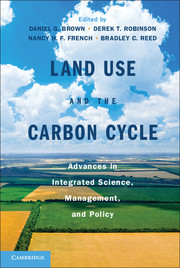Book contents
- Frontmatter
- Contents
- Chapter Authors and Affiliations
- Acknowledgments
- Acronyms
- Part I Introduction
- Part II Measurement and Modeling
- Part III Integrated Science and Research Applications
- Part IV Land Policy, Management, and the Carbon Cycle
- 13 Managing Carbon: Ecological Limits and Constraints
- 14 Effects of Wildland Fire Management on Forest Carbon Stores
- 15 Soil Carbon Dynamics in Agricultural Systems
- 16 U.S. Policies and Greenhouse Gas Mitigation in Agriculture
- 17 Opportunities and Challenges for Offsetting Greenhouse Gas Emissions with Forests
- 18 Opportunities and Challenges for Carbon Management on U.S. Public Lands
- 19 Design and Planning of Residential Landscapes to Manage the Carbon Cycle: Invention and Variation in Land Use and Land Cover
- Part V Synthesis and Future Directions
- Index
- Plate Section
- References
13 - Managing Carbon: Ecological Limits and Constraints
Published online by Cambridge University Press: 05 February 2013
- Frontmatter
- Contents
- Chapter Authors and Affiliations
- Acknowledgments
- Acronyms
- Part I Introduction
- Part II Measurement and Modeling
- Part III Integrated Science and Research Applications
- Part IV Land Policy, Management, and the Carbon Cycle
- 13 Managing Carbon: Ecological Limits and Constraints
- 14 Effects of Wildland Fire Management on Forest Carbon Stores
- 15 Soil Carbon Dynamics in Agricultural Systems
- 16 U.S. Policies and Greenhouse Gas Mitigation in Agriculture
- 17 Opportunities and Challenges for Offsetting Greenhouse Gas Emissions with Forests
- 18 Opportunities and Challenges for Carbon Management on U.S. Public Lands
- 19 Design and Planning of Residential Landscapes to Manage the Carbon Cycle: Invention and Variation in Land Use and Land Cover
- Part V Synthesis and Future Directions
- Index
- Plate Section
- References
Summary
Introduction
Humans have been managing terrestrial carbon (C) since time immemorial as a way to obtain energy stored in vegetation, food, and fiber from domesticated crops and animals, as well as wood products from forests. This manipulation of terrestrial C, inadvertent at first, has been more deliberate since 1800 and led to a net release of C to the atmosphere of about 200 Pg C since then. The net annual carbon dioxide (CO2) flux to the atmosphere from vegetation and soils, currently estimated at 1.2 Pg C·y−1 mainly due to land-use changes in tropical environments, is a major factor contributing to rising atmospheric CO2.
In 1977, Freeman Dyson hypothesized that the accumulation of CO2 in the atmosphere could be controlled via tree planting and estimated that approximately 4.5 Pg C · y−1 could be sequestered this way (Dyson 1977). The possibility of storing C in soils as a way to mitigate atmospheric CO2 increase and to restore lost soil organic matter and fertility emerged about two decades ago. Cole et al. (1997) estimated that about two-thirds of the historical losses of soil organic carbon (SOC) (approximately 40 Pg C) could be sequestered over 50 to 100 years through the implementation of nutrient management, cropping intensity, diversified crop rotation, and reduced tillage practices. In the Intergovernmental Panel on Climate Change (IPCC) second assessment report, Brown et al. (1996) estimated that about 38 Pg C could be sequestered on 345 × 106 hectares during 50 years via afforestation, reforestation, and agroforestry practices. Indeed, the Kyoto Protocol recognized afforestation and reforestation as mitigation practices implementable through the Clean Development Mechanism (CDM). Although the importance of soils as a C repository was recognized in the Kyoto Protocol, this technology was not included as a mitigation practice during the first commitment period (2008 to 2012) due to measurement uncertainties.
- Type
- Chapter
- Information
- Land Use and the Carbon CycleAdvances in Integrated Science, Management, and Policy, pp. 331 - 358Publisher: Cambridge University PressPrint publication year: 2013
References
- 1
- Cited by



